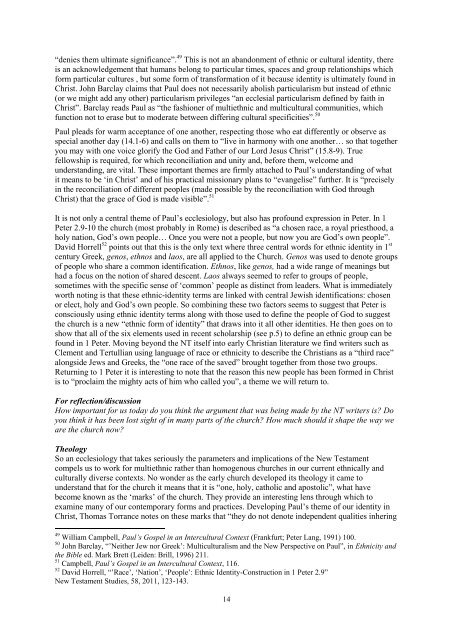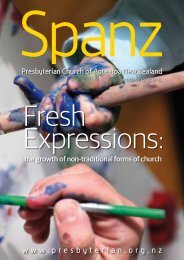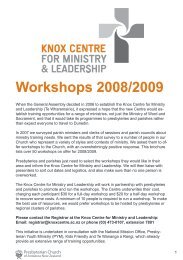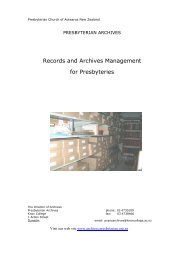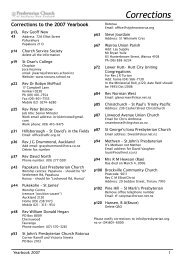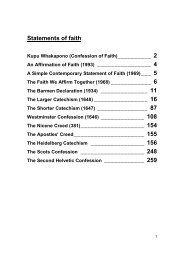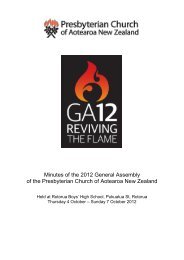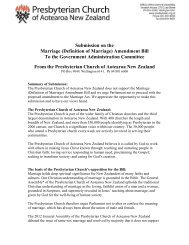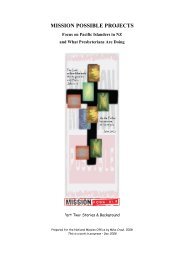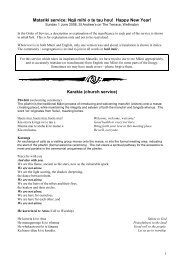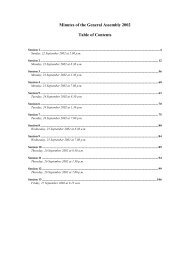Cultural diversity and unity in Christ: the Presbyterian Church of ...
Cultural diversity and unity in Christ: the Presbyterian Church of ...
Cultural diversity and unity in Christ: the Presbyterian Church of ...
You also want an ePaper? Increase the reach of your titles
YUMPU automatically turns print PDFs into web optimized ePapers that Google loves.
“denies <strong>the</strong>m ultimate significance”. 49 This is not an ab<strong>and</strong>onment <strong>of</strong> ethnic or cultural identity, <strong>the</strong>re<br />
is an acknowledgement that humans belong to particular times, spaces <strong>and</strong> group relationships which<br />
form particular cultures , but some form <strong>of</strong> transformation <strong>of</strong> it because identity is ultimately found <strong>in</strong><br />
<strong>Christ</strong>. John Barclay claims that Paul does not necessarily abolish particularism but <strong>in</strong>stead <strong>of</strong> ethnic<br />
(or we might add any o<strong>the</strong>r) particularism privileges “an ecclesial particularism def<strong>in</strong>ed by faith <strong>in</strong><br />
<strong>Christ</strong>”. Barclay reads Paul as “<strong>the</strong> fashioner <strong>of</strong> multiethnic <strong>and</strong> multicultural communities, which<br />
function not to erase but to moderate between differ<strong>in</strong>g cultural specificities”. 50<br />
Paul pleads for warm acceptance <strong>of</strong> one ano<strong>the</strong>r, respect<strong>in</strong>g those who eat differently or observe as<br />
special ano<strong>the</strong>r day (14.1-6) <strong>and</strong> calls on <strong>the</strong>m to “live <strong>in</strong> harmony with one ano<strong>the</strong>r… so that toge<strong>the</strong>r<br />
you may with one voice glorify <strong>the</strong> God <strong>and</strong> Fa<strong>the</strong>r <strong>of</strong> our Lord Jesus <strong>Christ</strong>” (15.8-9). True<br />
fellowship is required, for which reconciliation <strong>and</strong> <strong>unity</strong> <strong>and</strong>, before <strong>the</strong>m, welcome <strong>and</strong><br />
underst<strong>and</strong><strong>in</strong>g, are vital. These important <strong>the</strong>mes are firmly attached to Paul’s underst<strong>and</strong><strong>in</strong>g <strong>of</strong> what<br />
it means to be ‘<strong>in</strong> <strong>Christ</strong>’ <strong>and</strong> <strong>of</strong> his practical missionary plans to “evangelise” fur<strong>the</strong>r. It is “precisely<br />
<strong>in</strong> <strong>the</strong> reconciliation <strong>of</strong> different peoples (made possible by <strong>the</strong> reconciliation with God through<br />
<strong>Christ</strong>) that <strong>the</strong> grace <strong>of</strong> God is made visible”. 51<br />
It is not only a central <strong>the</strong>me <strong>of</strong> Paul’s ecclesiology, but also has pr<strong>of</strong>ound expression <strong>in</strong> Peter. In 1<br />
Peter 2.9-10 <strong>the</strong> church (most probably <strong>in</strong> Rome) is described as “a chosen race, a royal priesthood, a<br />
holy nation, God’s own people… Once you were not a people, but now you are God’s own people”.<br />
David Horrell 52 po<strong>in</strong>ts out that this is <strong>the</strong> only text where three central words for ethnic identity <strong>in</strong> 1 st<br />
century Greek, genos, ethnos <strong>and</strong> laos, are all applied to <strong>the</strong> <strong>Church</strong>. Genos was used to denote groups<br />
<strong>of</strong> people who share a common identification. Ethnos, like genos, had a wide range <strong>of</strong> mean<strong>in</strong>gs but<br />
had a focus on <strong>the</strong> notion <strong>of</strong> shared descent. Laos always seemed to refer to groups <strong>of</strong> people,<br />
sometimes with <strong>the</strong> specific sense <strong>of</strong> ‘common’ people as dist<strong>in</strong>ct from leaders. What is immediately<br />
worth not<strong>in</strong>g is that <strong>the</strong>se ethnic-identity terms are l<strong>in</strong>ked with central Jewish identifications: chosen<br />
or elect, holy <strong>and</strong> God’s own people. So comb<strong>in</strong><strong>in</strong>g <strong>the</strong>se two factors seems to suggest that Peter is<br />
consciously us<strong>in</strong>g ethnic identity terms along with those used to def<strong>in</strong>e <strong>the</strong> people <strong>of</strong> God to suggest<br />
<strong>the</strong> church is a new “ethnic form <strong>of</strong> identity” that draws <strong>in</strong>to it all o<strong>the</strong>r identities. He <strong>the</strong>n goes on to<br />
show that all <strong>of</strong> <strong>the</strong> six elements used <strong>in</strong> recent scholarship (see p.5) to def<strong>in</strong>e an ethnic group can be<br />
found <strong>in</strong> 1 Peter. Mov<strong>in</strong>g beyond <strong>the</strong> NT itself <strong>in</strong>to early <strong>Christ</strong>ian literature we f<strong>in</strong>d writers such as<br />
Clement <strong>and</strong> Tertullian us<strong>in</strong>g language <strong>of</strong> race or ethnicity to describe <strong>the</strong> <strong>Christ</strong>ians as a “third race”<br />
alongside Jews <strong>and</strong> Greeks, <strong>the</strong> “one race <strong>of</strong> <strong>the</strong> saved” brought toge<strong>the</strong>r from those two groups.<br />
Return<strong>in</strong>g to 1 Peter it is <strong>in</strong>terest<strong>in</strong>g to note that <strong>the</strong> reason this new people has been formed <strong>in</strong> <strong>Christ</strong><br />
is to “proclaim <strong>the</strong> mighty acts <strong>of</strong> him who called you”, a <strong>the</strong>me we will return to.<br />
For reflection/discussion<br />
How important for us today do you th<strong>in</strong>k <strong>the</strong> argument that was be<strong>in</strong>g made by <strong>the</strong> NT writers is? Do<br />
you th<strong>in</strong>k it has been lost sight <strong>of</strong> <strong>in</strong> many parts <strong>of</strong> <strong>the</strong> church? How much should it shape <strong>the</strong> way we<br />
are <strong>the</strong> church now?<br />
Theology<br />
So an ecclesiology that takes seriously <strong>the</strong> parameters <strong>and</strong> implications <strong>of</strong> <strong>the</strong> New Testament<br />
compels us to work for multiethnic ra<strong>the</strong>r than homogenous churches <strong>in</strong> our current ethnically <strong>and</strong><br />
culturally diverse contexts. No wonder as <strong>the</strong> early church developed its <strong>the</strong>ology it came to<br />
underst<strong>and</strong> that for <strong>the</strong> church it means that it is “one, holy, catholic <strong>and</strong> apostolic”, what have<br />
become known as <strong>the</strong> ‘marks’ <strong>of</strong> <strong>the</strong> church. They provide an <strong>in</strong>terest<strong>in</strong>g lens through which to<br />
exam<strong>in</strong>e many <strong>of</strong> our contemporary forms <strong>and</strong> practices. Develop<strong>in</strong>g Paul’s <strong>the</strong>me <strong>of</strong> our identity <strong>in</strong><br />
<strong>Christ</strong>, Thomas Torrance notes on <strong>the</strong>se marks that “<strong>the</strong>y do not denote <strong>in</strong>dependent qualities <strong>in</strong>her<strong>in</strong>g<br />
49 William Campbell, Paul’s Gospel <strong>in</strong> an Intercultural Context (Frankfurt; Peter Lang, 1991) 100.<br />
50 John Barclay, “’Nei<strong>the</strong>r Jew nor Greek’: Multiculturalism <strong>and</strong> <strong>the</strong> New Perspective on Paul”, <strong>in</strong> Ethnicity <strong>and</strong><br />
<strong>the</strong> Bible ed. Mark Brett (Leiden: Brill, 1996) 211.<br />
51 Campbell, Paul’s Gospel <strong>in</strong> an Intercultural Context, 116.<br />
52 David Horrell, “’Race’, ‘Nation’, ‘People’: Ethnic Identity-Construction <strong>in</strong> 1 Peter 2.9”<br />
New Testament Studies, 58, 2011, 123-143.<br />
14


